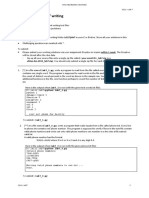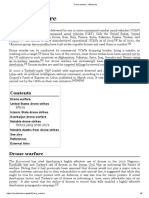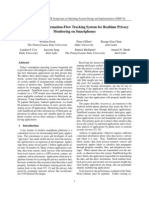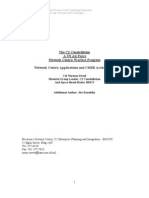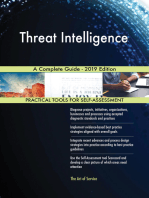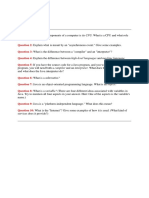Game of Drones Whitepaper
Game of Drones Whitepaper
Uploaded by
madil81Copyright:
Available Formats
Game of Drones Whitepaper
Game of Drones Whitepaper
Uploaded by
madil81Original Description:
Copyright
Available Formats
Share this document
Did you find this document useful?
Is this content inappropriate?
Copyright:
Available Formats
Game of Drones Whitepaper
Game of Drones Whitepaper
Uploaded by
madil81Copyright:
Available Formats
GAME OF DRONES
Whitepaper
www.juniperresearch.com
GAME OF DRONES
1.1 Introduction
For a number of years, the term drones to many people
referred to an UAV (unmanned aerial vehicle), ie an
aircraft with no human pilot aboard, being used by the
armed forces for either covert surveillance or to undertake
combat operations in major conflicts and war-torn areas of
the globe.
These military UAV sorties are either autonomous, guided
by GPS, or are under the control of a user, potentially
hundreds of miles away, using onboard cameras for
guidance.
significant risks and is hindered by rigorous regulation. Indeed, the regulatory environment
currently plays a crucial role in adoption where the rules of operating a UAV vary widely from
country to country in terms of their severity.
1.2 Drone Classification
Generally, UAVs are either:
Fixed-wing, similar in design to an airplane, or;
Based on a system of rotors, which are more akin to the workings of a helicopter.
Figure 1: Drone Diversity
While the military still accounts for a significant part of the
drone market, there is now a growing desire to utilise the
technology in commercial and consumer applications, ie
non-military or civilian.
Indeed, a growing ecosystem of drone software and
hardware vendors is already providing applications to
clients in a number of industry sectors, notably agriculture,
public services, land management, energy and
construction.
With the increasing amounts of money from venture
capitalists being ploughed into drone start-ups worldwide,
there is undoubted promise for the technology being used
successfully in civilian applications, but its potential carries
Source: Wall Street Journal
GAME OF DRONES
The market for civilian drones can be split into 2 main
types:
Retail/consumer mainly bought by consumers for
leisure and recreational pursuits;
Commercial/professional acquired by professionals
and companies to serve and meet the requirements of
their particular industry needs.
The types on offer range from those that are more akin to a toy through to those with
high-spec components, which are aimed at the prosumer and professional.
Indeed, at the high end it is difficult to determine where the consumer target market ends and
those aimed at the commercial sector start.
Figure 2: Consumer Drone Comparison
The market is completed by a third sector, military drones,
which are outside this analysis.
There is a distinct level of delineation between these types
of UAV used in these sectors, mainly through size and
price, which is shown below.
1.2.1 Sector Focus: Consumer Drones
In the consumer category, UAVs are mainly the preserve
of the hobbyist for recreational purposes, allied to a
burgeoning market for DIY modellers.
The addition of an on-board camera also opens
opportunities for a number of applications pertinent to
todays YouTube generation.
Consumer drones are most likely to be of the multicopter type and can be purchased through a variety of
retail outlets for as little as 30 ($45).
Source: Juniper Research/Amazon.co.uk
GAME OF DRONES
1.3 Key Consumer Applications
The consumer sector has long been associated with devices akin to UAVs,
namely radio controlled vehicles and model aircraft, ranging from
childrens toys to those aimed at, and built by, serious hobbyists,
enthusiasts and DIYers alike covering a full spectrum of consumers.
While todays UAVs offer certain technical enhancements over radio
controlled vehicles that brings them more into line with computers and
smartphones, there are a number of similarities that exist between the 2
categories, namely that they are still used for purely recreational and
entertainment purposes while also being a target for the keen hobbyist.
UAVs now allow much more with the addition of a camera
The ease with which consumers are able to acquire a UAV, though, could
spark any number of problems.
While drones, in their nascent development, are mainly acquired by
hobbyists for recreational purposes, there could be other demand
drivers, potentially nefarious, at play. Indeed, there have already been
some incidences worldwide of unsavoury, invasive and questionable
uses of drones by members of the general public.
While a number of cases have involved users being caught flying UAVs
near restricted areas, such as close to an airport or over a sports
stadium, some of the more insalubrious cases include carrying illegal
drugs across borders and smuggling deliveries into prisons, where the
drone has carried guns and various types of contraband.
Other more serious use cases have fortunately not yet happened, but
could include among acts of terrorism. This is becoming a major concern
for the public and hence governments are issuing stringent regulations
about their use.
It is also in the hands of those in the bona fide UAV consumer
community to help educate the public and temper these fears to keep
their hobby out of the headlines.
and the interaction with smartphones and tablets which, in
turn, opens up a whole new world of applications and
games for the consumer.
The release of Software Development Kits by the major drone
manufacturers also allows consumers and start-ups to create applications
and provide innovation in the sector.
Moreover, the barriers to entry for consumers are low in most developed
markets as off-the-shelf UAVs are easy to acquire, mainly through online
retail stores, with retail prices starting as low as $30 with camera.
This is a massive problem for the industry as it struggles to strike a
balance between regulating the use of consumer drones to ensure public
safety and privacy, while encouraging growth in the sector.
To combat any use of a UAV that impinges on public safety, the issue is
how they are to be best policed and monitored in the consumer market, as
GAME OF DRONES
it is not as easily regulated and purchases are not tracked with the same
rigour as those in the commercial sector.
Indeed, some consumers have taken it upon themselves to act as
vigilantes, with cases of UAVs being shot down.
Aside from simple recreational use, there are 2 main UAV use cases for
the consumer segment where enhancements and business opportunities
are being explored:
Photography and video footage;
Applications and enhanced games.
the FAAs Know Before You Fly promotion in the US;
the CAAs You have control poster in the UK; and
Flying an Unmanned Aircraft? educational directive from Canada
Transport.
Figure 3: You have control Safety Campaign
These examples are mainly based around the use of the smartphone and
tablet as the point of interaction with the UAV, which offer a window to a
host of online social media sites and application stores.
1.3.1 Private & Recreational Legislation
UAVs used only for hobby or recreational purposes are expected to follow
a set of safety guidelines in order not to endanger any member of the
public or any other object.
While these parameters can differ slightly from country to country, they
form the basis of most regulation and do not often require any permissions
or approvals for operation.
Many countries have implemented campaigns to educate the public about
using UAVs safely and responsibly so that these operational limitation
guidelines are adhered to, such as:
Source: CAA, UK
1.4 Consumer Drones: Forecast Summary
Juniper estimated that the vast majority of drones sold in 2014 were for the
consumer/prosumer sector, owing to the current availability of these types
of drones in the market from analysis of the largest vendors portfolios.
In general, products from the major vendors are targeted at consumers
but, as mentioned, it is difficult to determine their ultimate use as many are
GAME OF DRONES
well equipped enough to be used in a commercial environment, are of a
relatively high price and packed with requisite technology.
Figure 4: Total Consumer Drones Volume Sales (m), Split by 8
Key Regions 2020: 16.3 million
Juniper Research forecasts that over time, sales of
consumer drones will increase as the market expands to
16.3 million by 2020.
This will mainly be driven by:
Improvements in technology;
Increasing numbers of innovative applications;
Reductions in retail price, both through natural economies of scale, and
the introduction of standardised chipset platforms; and
Increased competition.
North America
Latin America
West Europe
Central & East Europe
Far East & China
Indian Subcontinent
Rest of Asia Pacific
Africa & Middle East
Source: Juniper Research
GAME OF DRONES
Order the Full Research
Market Trends & Competitive Landscape - strategic analysis of key
trends in the consumer and commercial drones space, together with
drone vendor capability assessment and matrix (PDF).
Market Sizing & Forecasts 5 year forecasts for drone shipments,
installed base and cost saving/revenue opportunities, split by
commercial and consumer markets (PDF).
Interactive Forecast Excel Highly granular dataset comprising nearly
3,700 data points, allied to an Interactive Scenario tool giving user the
ability to manipulate Junipers data (Interactive XL).
Drones: Consumer & Commercial Applications, Regulations &
Opportunities 2015-2020
This new study from Juniper Research provides an exhaustive
assessment of the burgeoning market for civilian UAVs (Unmanned Aerial
Vehicles), offering complete coverage of both the commercial and
consumer sectors. With an in-depth analysis of the latest trends,
developments and opportunities in the space, this research provides an
essential guide for industry stakeholders.
Key Features
Publications Details
Industry value chain and supply chain analysis.
Publication date: November 2015
Market challenge assessment.
Authors: Windsor Holden & Dave McQueen
Macro-environmental analysis including social, regulatory and
technological factors.
Contact Jon King, Business Development Manager, for more information:
Jon.King@juniperresearch.com
Market forecasts for consumer and commercial drones, including
shipments and installed base by price band, use case, region and
selected national markets; hardware revenues; revenues/cost savings
delivered by commercial drones, by use case and region.
Juniper Research Ltd, Church Cottage House, Church Square,
Basingstoke, Hampshire RG21 7QW UK
Tel: UK: +44 (0)1256 830001/475656 USA: +1 408 716 5483
(International answering service) Fax: +44(0)1256 830093
Whats in this Research?
http://www.juniperresearch.com
Executive Summary - Slide set summarising key trends, competitive
analysis and market forecasts, allied to a series of strategic
recommendations for players across the value chain (PPT).
You might also like
- Google - Prep4sure - Cloud Digital Leader - Vce.2024 Apr 08.by - Lester.141q.vceDocument7 pagesGoogle - Prep4sure - Cloud Digital Leader - Vce.2024 Apr 08.by - Lester.141q.vcePramod UppalNo ratings yet
- Lab 7 v1Document2 pagesLab 7 v1Darren ChoyNo ratings yet
- Hands On Artificial Intelligence For IoT Prefinal1 PDFDocument48 pagesHands On Artificial Intelligence For IoT Prefinal1 PDFaaaaNo ratings yet
- 070-298 MSPress - Designing and Managing A Windows Public Key Infrastructure (MOC 2821A) PDFDocument698 pages070-298 MSPress - Designing and Managing A Windows Public Key Infrastructure (MOC 2821A) PDFdanilofantinatoNo ratings yet
- Drone TechnologyDocument2 pagesDrone Technologymohammadfahri FerdiansyahNo ratings yet
- Swarm-Based Counter UAV Defense SystemDocument27 pagesSwarm-Based Counter UAV Defense SystemArthur WongNo ratings yet
- Autonomous Air Space Management & Control System: Presented By:-Prabh Simranjeet Singh AhluwaliaDocument39 pagesAutonomous Air Space Management & Control System: Presented By:-Prabh Simranjeet Singh AhluwaliaSimranAhluwaliaNo ratings yet
- Single and Multiple Drones Detection and Identification Using RF Based DeepDocument15 pagesSingle and Multiple Drones Detection and Identification Using RF Based DeepAmbrose SmithNo ratings yet
- Global Action Plan For The Prevention of Runway Incursions: Volume I - RecommendationsDocument25 pagesGlobal Action Plan For The Prevention of Runway Incursions: Volume I - RecommendationsJuliano Micheletto BergmannNo ratings yet
- PWC- DRONE INDUSTRY ANALYSIS DOCUMENTDocument40 pagesPWC- DRONE INDUSTRY ANALYSIS DOCUMENTipl03nishchayrNo ratings yet
- Armed Drones AFF - Wake 2015Document153 pagesArmed Drones AFF - Wake 2015AmoghDendukuriNo ratings yet
- Countering Terrorism On Tomorrow S Battlefield Critical InfrastrDocument274 pagesCountering Terrorism On Tomorrow S Battlefield Critical InfrastrBarton SealNo ratings yet
- Victory Briefs - SEP2024 Briefs (1)Document292 pagesVictory Briefs - SEP2024 Briefs (1)austinjin3234No ratings yet
- Drone Warfare - WikipediaDocument8 pagesDrone Warfare - WikipediaRohan Shirodkar RSPNo ratings yet
- The Civilian Impact of DronesDocument83 pagesThe Civilian Impact of DronesEhtasham AliNo ratings yet
- Drones. Unmanned Civil AviationDocument26 pagesDrones. Unmanned Civil AviationMarch ElleneNo ratings yet
- Theorizing The Image For Security Studies: Visual Securitization and The Muhammad Cartoon CrisisDocument24 pagesTheorizing The Image For Security Studies: Visual Securitization and The Muhammad Cartoon CrisisMario SantosNo ratings yet
- Counter-Unmanned Aircraft System(s) (C-UAS) : State of The Art, Challenges and Future TrendsDocument20 pagesCounter-Unmanned Aircraft System(s) (C-UAS) : State of The Art, Challenges and Future TrendsMahmud HasanNo ratings yet
- Drone Survival GuideDocument2 pagesDrone Survival GuidevthiseasNo ratings yet
- Hybrid Warfare: Russia and Achieving Strategic Goals Without Use of Outright Military ForceDocument16 pagesHybrid Warfare: Russia and Achieving Strategic Goals Without Use of Outright Military ForceAmna KhanNo ratings yet
- Cyber-Attacks Against Iran As Instruments of Hybrid WarfareDocument68 pagesCyber-Attacks Against Iran As Instruments of Hybrid WarfareVICENTE JOSUE AULAR RODRIGUEZNo ratings yet
- Face The Future Concepts of Force DesignDocument82 pagesFace The Future Concepts of Force DesignStuff NewsroomNo ratings yet
- A Survey of Cyberattack Countermeasures For UnmannDocument20 pagesA Survey of Cyberattack Countermeasures For UnmannLuiz Henrique CustódioNo ratings yet
- Drone TechnologyDocument18 pagesDrone TechnologyNik Humairah Putri JamilinNo ratings yet
- Balkan Regional Approach To Air Defence (BRAAD) PDFDocument4 pagesBalkan Regional Approach To Air Defence (BRAAD) PDFAnonymous jMeaKZb7rNo ratings yet
- TaintDroid - An Information-Flow Tracking System For Realtime PrivacyDocument15 pagesTaintDroid - An Information-Flow Tracking System For Realtime Privacyedward.rhodes4760No ratings yet
- Drone Detection Through Live Camera Using YOLOv3Document8 pagesDrone Detection Through Live Camera Using YOLOv3Ayapilla Sri hari PranavNo ratings yet
- Whitepaper Countering The CUAS ShortcomingsDocument4 pagesWhitepaper Countering The CUAS ShortcomingsCrit John KennedyNo ratings yet
- Beyond The FenceDocument10 pagesBeyond The Fencemiladh1No ratings yet
- Armed UAVs Chinese WJ 700 DT 21 Mar 2021Document2 pagesArmed UAVs Chinese WJ 700 DT 21 Mar 2021Igor S RiosNo ratings yet
- A Survey of Anti-Tamper TechnologiesDocument5 pagesA Survey of Anti-Tamper TechnologiesAlancito MartinezNo ratings yet
- Drones TomorrowLab June2014Document11 pagesDrones TomorrowLab June2014Craneo LocoNo ratings yet
- e8a8752f-ec05-045d-13c5-91d2d662c296 (1)Document156 pagese8a8752f-ec05-045d-13c5-91d2d662c296 (1)Abbas MasudNo ratings yet
- C-IED Training and Education Resource Catalog - v2 - 508Document138 pagesC-IED Training and Education Resource Catalog - v2 - 508elazzabyoussefieddNo ratings yet
- Drones in Hybrid Warfare - 9-10Document2 pagesDrones in Hybrid Warfare - 9-10sakis lakisNo ratings yet
- Ai in Military Drones and Uavs - Current Applications: Machine VisionDocument6 pagesAi in Military Drones and Uavs - Current Applications: Machine VisionRashid Abu abdoonNo ratings yet
- Drone FeasibilityDocument30 pagesDrone FeasibilityAbhishek PatiyalNo ratings yet
- New Solutions For S&a and Firing Functions in Modern FuzesDocument21 pagesNew Solutions For S&a and Firing Functions in Modern FuzesedweeryNo ratings yet
- Detail Part Optimization On The F-35 Joint Strike FighterDocument14 pagesDetail Part Optimization On The F-35 Joint Strike Fighterzhangshengdong100% (3)
- Development of Modular Unmanned Surface Vehicle For Research and EducationDocument4 pagesDevelopment of Modular Unmanned Surface Vehicle For Research and EducationistancicNo ratings yet
- Hybrid Warfare and The Changing CharacterDocument9 pagesHybrid Warfare and The Changing CharacterVICENTE JOSUE AULAR RODRIGUEZNo ratings yet
- G.H. Raisoni College of Engineering TAE:1: DronesDocument7 pagesG.H. Raisoni College of Engineering TAE:1: DronespurveshNo ratings yet
- Electric Initiation SystemsDocument28 pagesElectric Initiation SystemsShitij Malhotra100% (1)
- Micro Air VehicleDocument186 pagesMicro Air Vehiclebinho58100% (1)
- 2006 06 01 ENG Cruise Missiles & Anti-Access StrategiesDocument52 pages2006 06 01 ENG Cruise Missiles & Anti-Access StrategiesRavi KiranNo ratings yet
- China Hybrid Warfare Book ChapterDocument32 pagesChina Hybrid Warfare Book Chapterabhay singhNo ratings yet
- Screenshot 2022-03-20 at 14.23.13Document1 pageScreenshot 2022-03-20 at 14.23.13hartlm0599No ratings yet
- Technologies For Future Precision Strike Missile Systems - Missile/Aircraft IntegrationDocument18 pagesTechnologies For Future Precision Strike Missile Systems - Missile/Aircraft IntegrationMohammad Reza MadadiNo ratings yet
- Micro UAVDocument8 pagesMicro UAVMOST PASONNo ratings yet
- Conceptual Framework-reference-Version-shortened-good Cover - Publication Office 1Document58 pagesConceptual Framework-reference-Version-shortened-good Cover - Publication Office 1Светлана СумецNo ratings yet
- NIJ - Through-The-Wall Sensors For Law Enforcement - Best Practices - Version 1.0 March 2014Document19 pagesNIJ - Through-The-Wall Sensors For Law Enforcement - Best Practices - Version 1.0 March 2014LIVE3ORDIENo ratings yet
- The Key To Real Customer Value Is Effective Supply Chain Management"Document5 pagesThe Key To Real Customer Value Is Effective Supply Chain Management"Chethan S RNo ratings yet
- Landmines Detection Using UAVDocument4 pagesLandmines Detection Using UAVAnonymous zKvy2YnL9INo ratings yet
- Catalogo OnlineDocument22 pagesCatalogo OnlineLuis Gabriel Gomez100% (1)
- связьDocument31 pagesсвязьmirevg9No ratings yet
- Air Defense System Solutions - ENG - 2016Document12 pagesAir Defense System Solutions - ENG - 2016Nugroho CW100% (1)
- Sisteme Combat UavDocument9 pagesSisteme Combat UavElena JelerNo ratings yet
- Air DominanceDocument40 pagesAir Dominancehannes0No ratings yet
- Adaptive Missile Guidance Using GpsDocument24 pagesAdaptive Missile Guidance Using GpsPadmarajPopNo ratings yet
- A Framework For International Cyber Stability: Report OnDocument40 pagesA Framework For International Cyber Stability: Report OnKumar SaurabhNo ratings yet
- Asymmetric Warfare: **Asymmetric Warfare: Strategies and Implications for Modern Combat**From EverandAsymmetric Warfare: **Asymmetric Warfare: Strategies and Implications for Modern Combat**No ratings yet
- On Track With Connected & Self-Driving Vehicles: WhitepaperDocument8 pagesOn Track With Connected & Self-Driving Vehicles: Whitepapermadil81No ratings yet
- Smart Toys Do Toys Dream of Digital LivesDocument6 pagesSmart Toys Do Toys Dream of Digital Livesmadil81No ratings yet
- The Rise of Virtual RealityDocument5 pagesThe Rise of Virtual Realitymadil81No ratings yet
- Sample InvoicDocument1 pageSample Invoicmadil81No ratings yet
- S-001 - E4 NORSOK Technical IntegrityDocument72 pagesS-001 - E4 NORSOK Technical IntegrityKris TrezegoalNo ratings yet
- Flow CorrelationsDocument86 pagesFlow Correlationsmadil81No ratings yet
- RemittancesDocument26 pagesRemittancesEdward JoseNo ratings yet
- Basic Math ReviewerDocument44 pagesBasic Math ReviewerJerald NgNo ratings yet
- Biometric-Assisted Unique Patient IdentifierDocument73 pagesBiometric-Assisted Unique Patient Identifieropeyemipeter4realNo ratings yet
- APA TablesDocument7 pagesAPA TablesYet Barreda BasbasNo ratings yet
- 15.module6 Decisiontree-Updated 14Document20 pages15.module6 Decisiontree-Updated 14justadityabistNo ratings yet
- Tomb Raider Chronicles - Cheats and Cheat Codes For PCDocument1 pageTomb Raider Chronicles - Cheats and Cheat Codes For PCClau gomesNo ratings yet
- The Biometrics System Based On Iris Image Processing: A ReviewDocument6 pagesThe Biometrics System Based On Iris Image Processing: A ReviewVidya ViduNo ratings yet
- Final - UNICEF Market Survey - Advert (14 Dec'23) To Share Via Social Media PDFDocument3 pagesFinal - UNICEF Market Survey - Advert (14 Dec'23) To Share Via Social Media PDFNoman HossainNo ratings yet
- Quiz Questions For Chapter 1Document19 pagesQuiz Questions For Chapter 1KidwvyneBeatsNo ratings yet
- Career Summary: Aditya XXXXXDocument10 pagesCareer Summary: Aditya XXXXXbosskamranNo ratings yet
- QTDM-Cause AnalysisDocument17 pagesQTDM-Cause AnalysisAnand PathakNo ratings yet
- SAP Innovation Awards 2020 Entry Pitch DeckDocument11 pagesSAP Innovation Awards 2020 Entry Pitch DeckalbanoteNo ratings yet
- Notary ResumeDocument8 pagesNotary Resumegtc0f9w8100% (1)
- Samsung SFD321B 070103Document31 pagesSamsung SFD321B 070103Joshua Castro RiveraNo ratings yet
- PSC Library: Scanned by CamscannerDocument12 pagesPSC Library: Scanned by CamscannerPrince JoseNo ratings yet
- 1Z0-1127-24 Exam QuestionsDocument12 pages1Z0-1127-24 Exam QuestionstgeryNo ratings yet
- Development and Optimization of Structures For The Protection of Nano UavDocument6 pagesDevelopment and Optimization of Structures For The Protection of Nano UavJandres MaldonadoNo ratings yet
- D-EOMOC001 (21) 09-15EN Bacnet ItalyDocument119 pagesD-EOMOC001 (21) 09-15EN Bacnet ItalyGustavo CorreiaNo ratings yet
- B6 Computing QuestionsDocument5 pagesB6 Computing Questionsprincedonkor177No ratings yet
- Summary of Westgard RulesDocument9 pagesSummary of Westgard RulesMarianne Bravo QueddengNo ratings yet
- MACHINE LEARNING: FRIEDRICH KITTLER (1943-2011) by Geoffrey Winthrop-Young, Eva Horn - Artforum - Com: in PrintDocument2 pagesMACHINE LEARNING: FRIEDRICH KITTLER (1943-2011) by Geoffrey Winthrop-Young, Eva Horn - Artforum - Com: in Printcron0No ratings yet
- Vcta-Lc800-Lc810 - LC820Document5 pagesVcta-Lc800-Lc810 - LC820qeeNo ratings yet
- Page 1 of 8 C:/Sprov8I Ss5/Staad/Building Design/Truss 2 - Final - AnlDocument8 pagesPage 1 of 8 C:/Sprov8I Ss5/Staad/Building Design/Truss 2 - Final - AnlLeomark RespondeNo ratings yet
- Zou 2016Document17 pagesZou 2016ranjithNo ratings yet
- Freshdesk Omnichannel - All Features DeckDocument82 pagesFreshdesk Omnichannel - All Features Decksopiyanaan53No ratings yet
- Tutorial: Week 8 Project Management (MGT215) MNU Business SchoolDocument2 pagesTutorial: Week 8 Project Management (MGT215) MNU Business SchoolMueen MajidNo ratings yet


